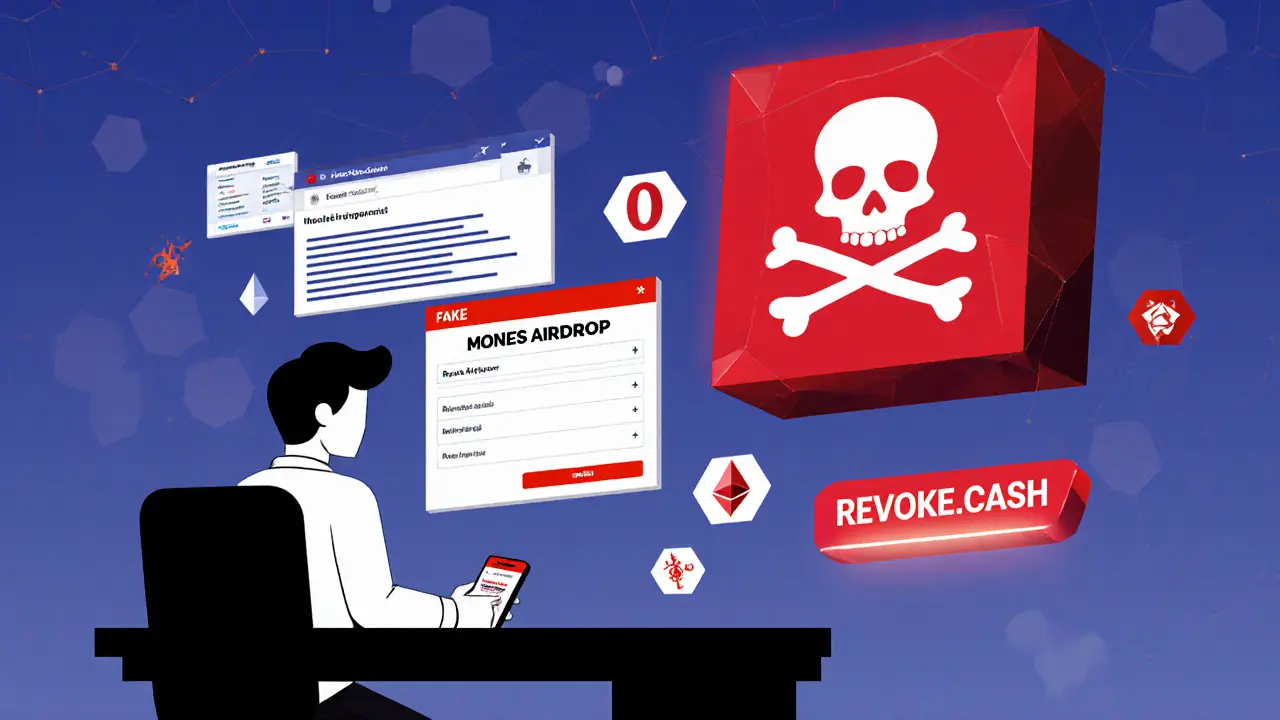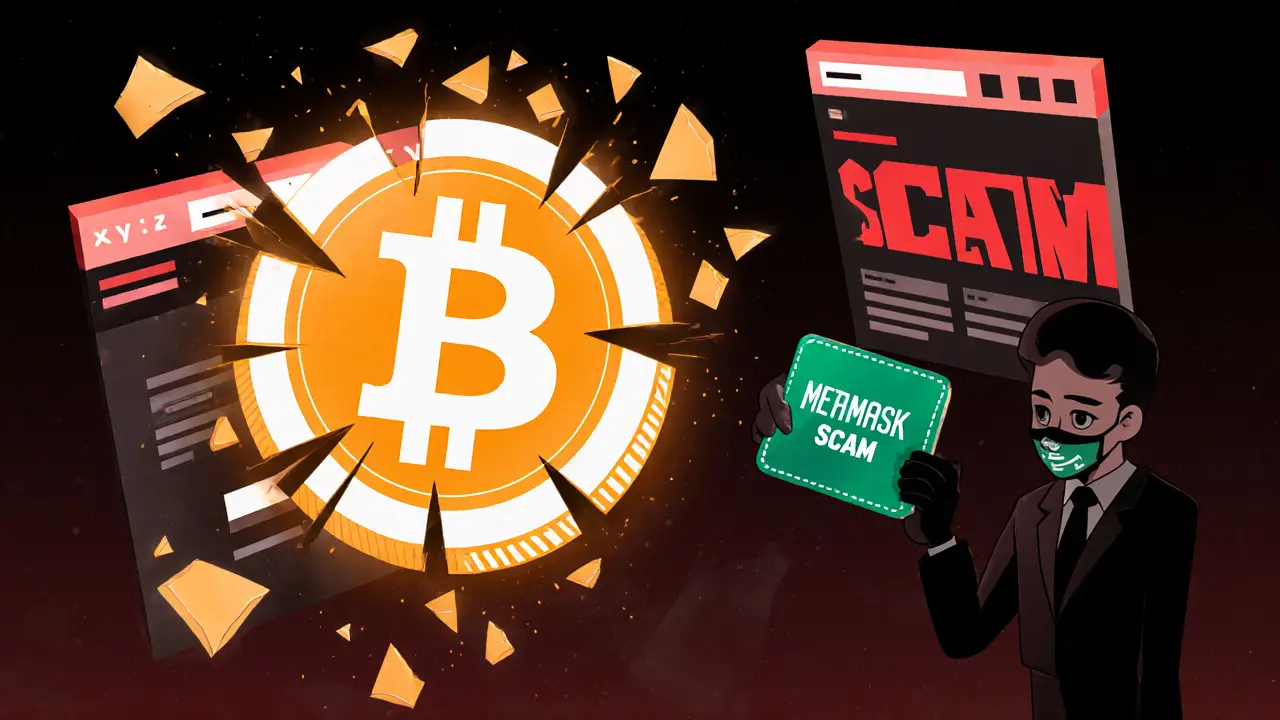There’s no official information about a Mones airdrop. Not from their website, not from their social media, not from any major crypto news site like CoinDesk, CoinTelegraph, or even Reddit’s r/CryptoCurrency. If you’ve seen a post claiming you can claim MONES tokens right now, you’re likely looking at a scam.
The name ‘Mones’ doesn’t appear in any blockchain explorer, token registry, or decentralized application list. No wallet supports MONES. No exchange lists it. No whitepaper exists online. Even blockchain analytics tools like Nansen or Dune don’t show any token activity tied to MONES.
Meanwhile, people are posting screenshots of fake airdrop portals - websites that ask you to connect your MetaMask, approve a transaction, and then vanish with your funds. These aren’t mistakes. They’re designed to look real. They copy the fonts, colors, and layout of legitimate projects. They even use fake Twitter accounts with green checks to spread the word. It’s happening right now, in November 2025.
Why does this keep happening? Because airdrops are the easiest way to trick new crypto users. People hear about people getting free tokens from Monad, Arbitrum, or zkSync, and they assume every new name is the same. But not every project with a token is real. Not every campaign is legitimate. And right now, Mones is not one of them.
What’s Real: Monad vs. Mones
You might be confused because you’ve seen headlines about Monad’s airdrop. Monad is a real Layer 1 blockchain. It raised $225 million. Its mainnet is expected to launch in late October 2025. It has a team, a codebase, and a public testnet with over 150,000 participants. Its airdrop - called Monad Momentum - is real. It’s being tracked on GitHub. It’s being discussed in Discord servers with verified admins.
Mones? Nothing. No GitHub repo. No Discord server with verified members. No team members listed. No press releases. No venture capital backing reported. No technical documentation. No transaction history on Etherscan or any other chain.
If Mones were real, you’d see:
- A website with a clear roadmap and team photos
- Public smart contracts audited by CertiK or Trail of Bits
- Active social channels with regular updates
- Tokenomics explained - total supply, distribution, vesting schedule
- Partnerships with known wallets or exchanges
None of that exists for Mones. Not even a single line of code has been published.
How to Spot a Fake Airdrop
Here’s how to protect yourself:
- Never connect your wallet to a site you don’t trust. Even if it says ‘Claim MONES,’ it’s not worth losing your ETH, stablecoins, or NFTs.
- Check the domain. Fake sites use .xyz, .io, or .app with slight misspellings like ‘mon3s.com’ or ‘mones-airdrop.net’.
- Look for official channels. If Mones had an airdrop, their Twitter/X and Telegram would be buzzing with verified announcements. Right now, they’re silent.
- Search for audits. Go to Certik or Trail of Bits and search for ‘Mones.’ You’ll get zero results.
- Check token contracts. Go to Etherscan, BscScan, or Solana Explorer and search for ‘MONES.’ No token exists.
Legit projects don’t hide. They announce. They document. They prove. If something sounds too easy - free tokens just for signing up - it’s almost always a trap.

What You Should Do Instead
If you want to participate in real airdrops in 2025, focus on projects with:
- Public mainnet launches
- Open-source code
- Clear eligibility rules (e.g., ‘Use the protocol for 30 days’)
- Community engagement on Discord or Telegram with mod-verified accounts
Right now, the only airdrop worth watching is Monad’s. It’s transparent. It’s documented. It’s backed by Paradigm and other top-tier investors. If you participated in its testnet, you might get rewarded. That’s real.
For Mones? Don’t waste your time. Don’t click. Don’t connect. Don’t even Google it further. The only thing you’ll find is a growing list of victims.

Why This Keeps Happening
Crypto attracts fraud because it’s fast, global, and poorly regulated. Scammers know that new users are excited, eager to get rich quick, and often don’t know how to verify legitimacy. They exploit that.
They use AI to generate fake logos, fake team bios, and fake press quotes. They buy fake followers on Twitter. They create fake YouTube videos with stock footage of people celebrating ‘Mones airdrop claims.’ They even make fake Reddit threads with upvotes from bot accounts.
It’s not just about money. It’s about trust. And when projects like Mones vanish, they erode confidence in the whole space. Real builders suffer because of these scams.
Don’t let yourself become part of the problem. Don’t share fake links. Don’t post screenshots of ‘Mones rewards.’ If you see someone falling for it, warn them. A simple comment like ‘This isn’t real - no contract exists’ could save someone thousands.
Final Warning
If you’ve already connected your wallet to a Mones site, act now:
- Revoke all token approvals using revoke.cash
- Check your transaction history on Etherscan for any unusual transfers
- Move your remaining funds to a new wallet
- Report the site to the FTC and CryptoScamDB
There’s no such thing as a free MONES token. Not today. Not tomorrow. Not ever - unless someone builds it and proves it. Until then, treat ‘Mones’ like a red flag. Walk away. Protect your assets. Stay safe.

Kevin Hayes
November 14, 2025 AT 09:37Let’s be clear: if a project has no whitepaper, no GitHub, no audit, and no team bio, it’s not a blockchain project-it’s a phishing page with a fancy name. The fact that people still fall for this is less about tech ignorance and more about the human tendency to believe in miracles. Free money? Of course I want it. But not if it costs me my entire portfolio.
Hannah Kleyn
November 15, 2025 AT 04:18I saw a DM yesterday saying ‘Mones airdrop live now’ with a link that looked exactly like the Monad site. I checked the URL-it was mon3s.io. I screenshot it and posted it in my local crypto group. Someone had already connected their wallet. They lost 2.3 ETH. I don’t get how people don’t check the domain first. It’s like walking into a bank that looks like Chase but has a different sign.
Vanshika Bahiya
November 16, 2025 AT 02:30For anyone new here: if you’re unsure about a token, go to Etherscan and search the contract address. If it’s not there, it’s not real. Also check CoinGecko or CoinMarketCap-no legitimate token slips through without being listed. And if you’re being asked to approve a transaction before claiming anything? That’s a red flag bigger than a neon sign in Times Square. You don’t approve anything unless you know exactly what you’re signing. Period.
Byron Kelleher
November 17, 2025 AT 12:21Bro I just got this link from a Discord server. Thought it was legit ‘cause the logo looked clean. Then I read the post above and checked revoke.cash-turns out I’d already approved a scam contract last week. Thanks for the heads up. Just revoked everything. Saved my assets. You guys are the real airdrop.
Becky Shea Cafouros
November 18, 2025 AT 00:33So… what’s the point of this post? Everyone knows airdrops are scams. Why write a 2000-word essay on something that’s been common since 2017?
Andrew Parker
November 18, 2025 AT 08:53It’s not about the tokens-it’s about the illusion. People don’t want to believe they’re being fooled. They want to believe in the dream. And scammers? They don’t sell tokens. They sell hope. That’s why this works. That’s why it’s profitable. That’s why it’ll keep happening until the next generation learns to ask: ‘Who’s behind this?’ before they click.
Kandice Dondona
November 18, 2025 AT 11:59Thank you for this!! 🙏 I almost clicked on a ‘Mones claim’ link last night-my cat jumped on my keyboard and I paused. Then I read your post. I’m so glad I didn’t. Stay safe out there, fam! 💪✨
Anthony Forsythe
November 19, 2025 AT 15:17There’s a metaphysical truth here, you know? The MONES scam isn’t just a financial trap-it’s a mirror. It reflects our collective addiction to instant reward, our rejection of patience, our hunger for validation through ownership. We don’t want to earn tokens-we want to be chosen. We want to be the one who got lucky. And that’s why the scam thrives. Not because it’s clever. But because we’re desperate.
Katherine Wagner
November 20, 2025 AT 06:22Actually I think you’re wrong. Mones might be real. Maybe it’s stealth launching. Maybe it’s on a private chain. Maybe the devs are waiting for the right moment. You can’t just say ‘no website = scam.’ What if they’re building in secret? What if you’re the one missing the bigger picture?
ratheesh chandran
November 20, 2025 AT 09:28bro i think mones is real becouse i saw a guy on tiktok with a green check and he said he got 50000 mones and he bought a ferrari now. i dont care if no contract exist. i trust the green check. i click now. wish me luck 🙏
gary buena
November 22, 2025 AT 05:17Wow. So if I connect my wallet to a site that says ‘Mones’ and it’s not real… I just lose money. Got it. But hey, at least I tried. That’s crypto, right? You win some, you lose some. I’m just glad I didn’t lose my dog NFTs. 😅
Kelly McSwiggan
November 23, 2025 AT 23:41Wow. Another ‘how to not get scammed’ post. How original. Did you also write a 10,000-word guide on ‘don’t drink poison’? Congratulations. You’ve saved the world from gravity. Meanwhile, the real scam is the entire ecosystem that lets this happen. Regulate. Or shut up.
Albert Melkonian
November 25, 2025 AT 11:13I appreciate the diligence and clarity of this post. In an environment where misinformation spreads faster than verified data, such comprehensive, evidence-based warnings are not merely helpful-they are essential. I urge all participants in the blockchain ecosystem to internalize these principles and share them with newcomers. Trust must be earned, not assumed.
Drew Monrad
November 26, 2025 AT 20:27Okay but what if Mones is a government-backed stealth project? Like… what if this is a test? What if the ‘scam’ is actually a honeypot to catch criminals? You’re assuming the worst. Maybe you’re the one being manipulated by the narrative.
Cherbey Gift
November 27, 2025 AT 17:52Man, this whole thing is like a spiritual lesson wrapped in a blockchain. Mones ain’t a token-it’s a test. A mirror. A wake-up call. If you click, you’re chasing shadows. If you walk away, you’re becoming the light. The universe doesn’t give free shit. It gives wisdom. And wisdom says: don’t connect. Don’t trust. Don’t hope. Just breathe.